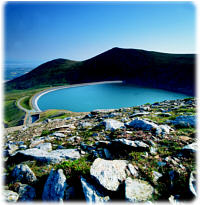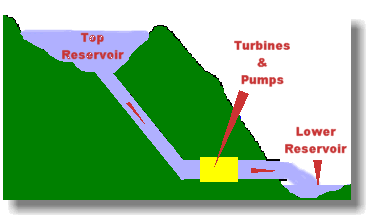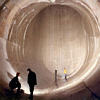![]()
![]()
![]()
![]()
![]()
![]()
![]()
![]()
![]()
![]()
![]()
This site is designed to be viewed on an
800 x 600 screen,
with level 4+ browsers.
Created by Andy Darvill,
Science teacher at
Broadoak Community School,
Weston-super-Mare, England
Web site www.darvill.clara.net
storing energy to cope with big demands
Introduction How it works More details Advantages Disadvantages Is it renewable?
![]()
 Introduction
Introduction
Pumped storage reservoirs aren't really a means of generating electrical power. They're a way of storing energy so that we can release it quickly when we need it.
Demand for electrical power changes throughout the day. For example, when a popular TV programme finishes, a huge number of people go out to the kitchen to put the kettle on, causing a sudden peak in demand.
If power stations don't generate more power immediately, there'll be power cuts around the country - traffic lights will go out, causing accidents, and all sorts of other trouble will occur.
The problem is that most of our power is generated by fossil fuel power stations, which take half an hour or so to crank themselves up to full power. Nuclear power stations take much longer.
We need something that can go from nothing to full power immediately, and keep us supplied for around half an hour until the other power stations catch up. Pumped storage reservoirs are the answer we've chosen.
![]()
How it works
Between 1976 and 1982 at Dinorwig, in North Wales, a huge project was built. Yet there's little to see as you drive past, as most of it is deep inside a mountain.
|
Water is pumped up to the top reservoir at night, when demand for power across the country is low. When there's a sudden demand for power, the "headgates" (huge taps) are opened, and water rushes down the tunnels to drive the turbines, which drive the powerful generators. The water then collects in the bottom reservoir, ready to be pumped back up later. |
 |
Dinorwig has the fastest "response time" of any pumped storage plant in the world - it can provide 1320 MegaWatts in 12 seconds. That's a lot of cups of tea!
![]()
More details about Dinorwig
When
water is pumped up to the top reservoir (called "Marchlyn Mawr")
we are storing gravitational potential energy in it. The greater the
height, the more energy is stored.
This is one of the reasons that the Dinorwig site was chosen - there
was a big height difference between two existing lakes, so less work
was needed to build the station.
 The water falls 600 metres on its way to the turbines,
so it's under a great deal of pressure when it arrives. For this reason,
the tunnels are lined with steel at the bottom end.
The water falls 600 metres on its way to the turbines,
so it's under a great deal of pressure when it arrives. For this reason,
the tunnels are lined with steel at the bottom end.
Each of the six generators is capable of producing 288 MegaWatts of power at 18,000 Volts, which is stepped up to 400,000 Volts by transformers and sent along underground cables to be fed into the "supergrid", which is the long-distance network of the National Grid.
Dinorwig has "pump/turbines", which can be used both as pumps for getting water from the lower to the upper reservoirs, and as turbines for generating electrical power.
There is a complex system of gutters in the roof of the caves, to collect water that drips down through the rock. Carol Vordeman worked on this part of the station - helping to design this was one of her first engineering jobs before she moved into television.
| You can find
out more about the Dinorwig station from First Hydro's web site. |
![]()
Advantages
- Without some
means of storing energy for quick release, we'd be in trouble.
- Little effect
on the landscape.
- No pollution or waste
![]()
Disadvantages
- Expensive to
build.
- Once it's used,
you can't use it again until you've pumped the water back up.
Good planning can get around this problem.
![]()
Is it renewable?
It's
not really a power station, but a means of storing energy from other
power stations.
So the question doesn't apply.